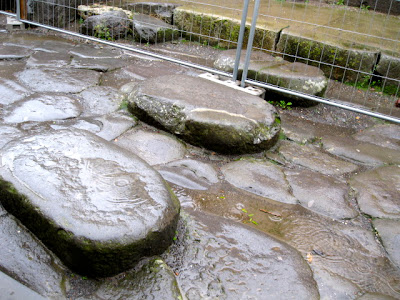I recently went on a site visit with my Ancient Roman Civilization class to Pompeii in the Bay of Naples. I was so excited because I had been studying Pompeii beginning in 10th grade with the Cambridge Latin Course. Unfortunately, as is common in the winter here in Italia, it was raining. But I refused to let the rain get me down!
We left Roma at 7am sharp and got to Pompeii a little after 10 listening to the wrath of Jove all the way down. We entered Pompeii on the Eastern side and the first thing I saw was the amphitheater. I leterally began jumping up and down. I had studied a wall painting of this amphitheater that depicted a riot between the Pomeiians and Nucerians (like a modern football riot during FIFA - or any day in Italia) which led to Pompeii losing arena privileges for 10 years.
 |
| Even the architecture is similarly depicted! |
 |
| Yes, my that is my professoressa's hand lecturing and my friend Sam photobombing... |
This immediate sealing of human remains preserved the bodies for a while until the porous quality of the rock allowed for the decomposition of the organic materials. When Pompeii was later being excavated by Giuseppe Fiorelli he noticed that there were air pockets in the lithified ash sometimes with bones inside them. He developed a method, now called the Fiorelli method, of pouring plaster into these spaces before they were excavated to preserve the shape inside. What he found was remarkable: human casts were made sometimes detailed enough to display facial features and garments. They show dramatic vignettes of the last moments of these peoples' lives. Some gathered together and tried to provide comfort to loved ones while others seem to have been caught running by the ash and had fallen to the ground to be subsequently covered by it.
 |
| From inside the Villa of Mysteries |
I also got to see the lupanar, the brothel of Pompeii. I just wrote a 16 page research paper on prostitution in Rome, so I'd rather not rehash the details... but how about some pictures! I hear they're worth a thousand words...
 |
| The stone bed in the working room of a meretrix (protsitute) |
 |
| Wall paintings in the lupanar - sort of like an assortment of things one can 'order.' |
We also got to see some notable pieces of art like mosaics from the House of the Faun and the infamous 'cave canem' (beware of dog) mosaic!
 |
| The moasic of Alexander the Great defeating Darius III at the Battle of Issus. |
 |
| It functions as a 'welcome' mat! |
 |
| Our new friend - Cerberus |
 |
| Scenes of the woman seated and learning lines on the left and getting dressed in the yellow on the right. |
 |
| Bacchus and the flagellation. |
 |
| Bacchus drunkenly reclining with his thyrsus whilst the woman is flagellated. |
 |
| The woman, seated, learning the lines from the scroll held by the young girl. |
 |
| Painted marble bordering the scene. |
 |
| The woman wearing the ring on her left hand. |
















No comments:
Post a Comment